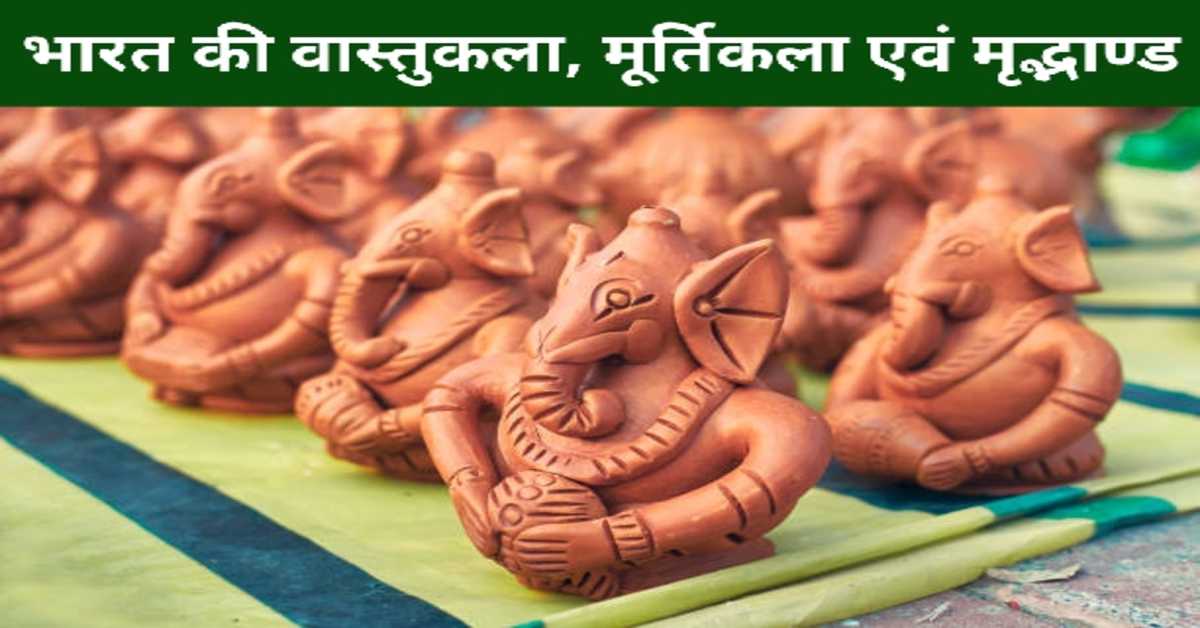
भारत की वास्तुकला, मूर्तिकला एवं मृद्भाण्ड | Architecture, Sculpture and Pottery of India
वास्तुकला और मूर्तिकला से तात्पर्य- वास्तुकला यानि आर्किटेक्चर लैटिन भाषा के शब्द 'ट्रैक्टन' से व्युत्पन्न है, जिसका अर्थ निर्माता (बिल्डर) होता है। प्रारंभ में जब आदिकालीन मानव ने आश्रय निर्माण की शुरुआत की, तभी से वास्तुकला विज्ञान का प्रादुर्भाव प्रारंभ हुआ। वहीं दूसरी ओर मूर्तिकला यानी स्कल्पचर शब्द प्रोटो-इंडो-यूरोपीय (पी.आई.ई.) मूल के 'केल' शब्द से व्युत्पन्न है, जिसका अर्थ मोड़ना होता है। मूर्तिकला, कला का लघु रूप है। मूर्तिकला, अभियांत्रिकी और मापन की तुलना में सौंदर्यशास्त्र से अधिक संबध्द होती है। मूर्तिकला या तो हस्तनिर्मित होती है या उपकरणों द्वारा बनाई जाती है।
Architecture and Sculpture- Architecture is derived from the Latin word 'tracton', which means Constructor (builder). Initially, when the primitive man started the construction of shelter, the science of architecture started from then only. On the other hand, the word sculpture is derived from the word 'kele' of Proto-Indo-European (PIE) origin, which means to bend. Sculpture is a miniature form of art. Sculpture is more concerned with aesthetics than with engineering and measurement. Sculpture is either handmade or made by tools.
इन 👇एतिहासिक महत्वपूर्ण प्रकरणों को भी पढ़ें।
1. विश्व की प्रथम चार सभ्यताएँ- मेसोपोटामिया, मिस्र, सिंधु, और चीनी सभ्यता
2. भारत का इतिहास- प्राचीन भारतीय इतिहास के अध्ययन के पुरातात्विक स्रोत।
3. भारत का इतिहास- प्राचीन भारतीय इतिहास जानने के साहित्यिक स्त्रोत- वेद
4. भारत का इतिहास- सिंधु सभ्यता के प्रमुख स्थल
5. सिन्धु सभ्यता में जीवन
मूर्तिकला और वास्तुकला में अंतर-
1. मूर्तियाँ, कला की लघु त्रिआयामी रचनाएँ होती हैं। जबकि वास्तुकला भवन के निर्माण और डिजाइन से संदर्भित होती हैं।
2. मूर्तियों के निर्माण के लिए सामान्यतः एक ही प्रकार की सामग्रियाँ प्रयुक्त होती हैं। जबकि भवन निर्माण के लिए पत्थर, लकड़ी, ईंट, काँच, धातु, रेत, मिट्टी आदि का प्रयोग किया जाता है। ये सभी वस्तुएँ प्रायः अलग-अलग प्रकार की होती हैं।
3. मूर्तिकला रचनात्मकता और कल्पना पर आधारित होती हैं। इसके लिए सटीक मापन की आवश्यकता नहीं होती। जबकि वास्तुकला अभियांत्रिकी और गणित के अध्ययन पर आधारित होती हैं। इसके लिए सटीक मापन की आवश्यकता होती है।
4. मूर्तिकला के प्रमुख उदाहरण नटराज, नर्तकी की कांस्य मूर्ति आदि हैं। वास्तुकला के प्रमुख उदाहरण लाल किला, ताजमहल आदि हैं।
Difference between Sculpture and Architecture -
1. Statues are miniature three-dimensional works of art. Whereas architecture refers to the construction and design of the building.
2. Commonly the same type of materials are used for making sculptures. Whereas stone, wood, brick, glass, metal, sand, clay etc. are used for building construction. All these things are usually of different types.
3. Sculptures are based on creativity and imagination. It does not require precise measurement. Whereas architecture is based on the study of engineering and mathematics. This requires accurate measurement.
4. Prominent examples of sculpture are Nataraja, Bronze statue of dancer etc. Prominent examples of architecture are Red Fort, Taj Mahal etc.
इन 👇एतिहासिक महत्वपूर्ण प्रकरणों को भी पढ़ें।
1. वैदिक सभ्यता- ऋग्वैदिक काल
2. मध्यप्रदेश का प्राचीन इतिहास
3. भारत का इतिहास- बुद्ध के समय के प्रमुख गणराज्य (गणतंत्र)
4. भारत का प्राचीन इतिहास-;जनपद एवं महाजनपद
5. भारत का प्राचीन इतिहास-;जनपद एवं महाजनपद
भारतीय वास्तुकला- भारतीय वास्तुकला की कहानी विकास की कहानी है। सिंधु घाटी सभ्यता से लेकर ब्रिटिश शासन तक भारतीय वास्तुकला के विकास की अपनी कहानी है। महान साम्राज्य के उद्भव और पतन, विदेशी शासकों के आक्रमण (जो धीरे-धीरे स्वदेशी हो गए), विभिन्न शैलियों और संस्कृतियों के मिश्रण (संगम) से भारतीय वास्तुकला का विकास हुआ।
Indian Architecture- The Story of Indian Architecture is a Story of Growth. The development of Indian architecture from the Indus Valley Civilization to the British rule has its own story. The rise and fall of great empires, invasions by foreign rulers (who gradually became indigenous), amalgamation (sangam) of different styles and cultures led to the development of Indian architecture.
भारतीय वास्तुकला का वर्गीकरण- इसे तीन भागों में वर्गीकृत किया जा सकता है-
1. प्राचीन भारत- इसके अंतर्गत सिंधु घाटी सभ्यता की कला, मौर्यकालीन कला, मौर्योत्तर कालीन कला, गुप्तकालीन कला और दक्षिण भारतीय कला शामिल हैं।
2. मध्यकालीन भारत- इसके अंतर्गत सल्तनत कालीन कला और मुगलकालीन कला शामिल हैं।
3. आधुनिक भारत- इसके अंतर्गत इंडो-गॉथिक शैली और नव-रोमन शैली शामिल हैं।
Classification of Indian Architecture- It can be classified into three parts-
1. Ancient India- It includes Art of Indus Valley Civilization, Mauryan Art, Post-Mauryan Art, Gupta Art and South Indian Art.
2. Medieval India- This includes the art of the Sultanate period and the art of the Mughal period.
3. Modern India- includes Indo-Gothic style and Neo-Roman style.
इन 👇एतिहासिक महत्वपूर्ण प्रकरणों को भी पढ़ें।
1. सिकंदर का भारत पर आक्रमण- इसके कारण एवं प्रभाव
2. जैन धर्म के 24 तीर्थंकर एवं महावीर स्वामी की पारिवारिक जानकारी
3. बौद्ध धर्म एवं बुद्ध का जीवन परिचय
4. मगध साम्राज्य का इतिहास | The Magadh Empire time period
आशा है यह लेख विभिन्न प्रकार की प्रतियोगिता परीक्षाओं की दृष्टि से महत्वपूर्ण एवं उपयोगी होगा।
धन्यवाद।
RFcompetition.com
आशा है, उपरोक्त जानकारी उपयोगी एवं महत्वपूर्ण होगी।
(I hope the above information will be useful and important. )
Thank you.
R. F. Tembhre
(Teacher)
pragyaab.com




Comments